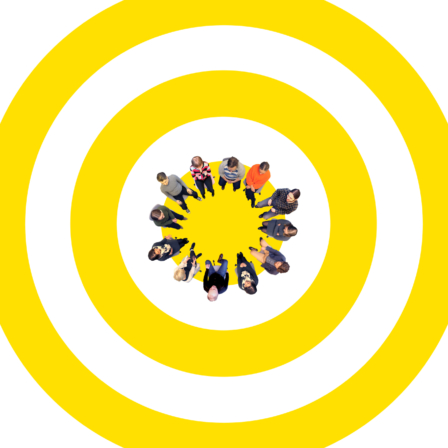Choose the dialogue method that best supports the objectives of the event. If there is enough time, you can also combine methods. Dialogues can be open or structured. If you are a beginner, it may be easier to start by trying a structured dialogue with a detailed script in which the time limits for speaking have been set in advance. As you gain more experience, it will be easier to move on to leading a more open dialogue.
The following methods can be used in a dialogue:
- Small group dialogues (fewer than 10 people) – discussions in which everyone has a chance to speak and in which one person speaks at a time
- Fishbowl discussions, in which a small group conducts a discussion and the others listen, taking turns
- Pair discussions, which can be used for tuning into the discussion topic or for deepening the discussion
- Cumulating pair discussions, in which the pairs are listened to alternately and the aim is to relate new contributions to the experiences
- Large group dialogues (more than 10 people) – pair discussions enable everyone to be heard
- Network dialogue
Surprises come with the territory and you will find useful advice for dealing with such situations here.
How?
Open dialogue
Make sure the only thing governing the content of the discussion is the possible theme that has been given or defined. If there is no theme, tell the participants that the intention is to talk about what is important for them at that particular moment. In the beginning, go over the ground rules and the roles in the discussion. Use some time for a round of introductions. The introductory question should be one that prepares the participants to talk about their experiences. Ask the participants whether they already know each other. Then, let the conversation flow at its own pace. Take advantage of the leading methods and even though the discussion is open, stick to the ground rules and, when necessary, intervene if people exceed the time limits set for the contributions and ensure that everyone has a chance to speak. At the end of an open dialogue, use some time to go over what has been discussed and how the participants have perceived the discussion. If the group finds it necessary, you can document the discussion on a flip board, for example.
Semi-structured dialogue
Draw up a loose script for the discussion. Think about what kind of question associated with the discussion theme could serve as the initial question. A good initial question is one that directs the participants to reflect on the theme under discussion through their own experiences. For example, such a question could be:
“Tell us about a situation in which you were proud of an issue/topic/group/work, etc.”
“Tell us about a personal experience during which you felt XXXX”
The initial question tunes the participants into speaking from experience and into the discussion theme. After the round, ask the group what they would now like to talk about in the dialogue.
“What do we need to talk about now?”
While you are listening, write down discussion topics on the flip board. When the flip board is full, ask the participants to choose the topic/topics (time allowing) that they most need to talk about. Depending on the size of the group and the width of the topics, you should reserve at least 30 minutes for one topic. If the group is unable to choose a topic on its own, step in and try to choose the topic that in your opinion is the most important one for the group. Say that you take the responsibility for choosing and make sure that the topic you choose is not an insurmountable problem to anyone.
At the end of the discussion, go over what kind of insights were gained into the topics and how the participants found the discussion.
Structured dialogue
Prepare by writing a script for the entire discussion. Plan the questions in advance and determine a strict time limit per participant for the answers. A suitable time for answering is about 2 minutes. In the beginning, it is necessary to time the answers and, as the discussion progresses, the participants usually start to pay attention to how much time is left themselves. In a structured dialogue, the questions go deeper and deeper into the theme.












More tools
Start the planning with these.